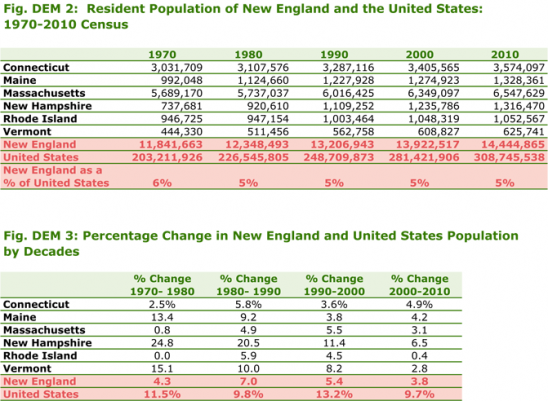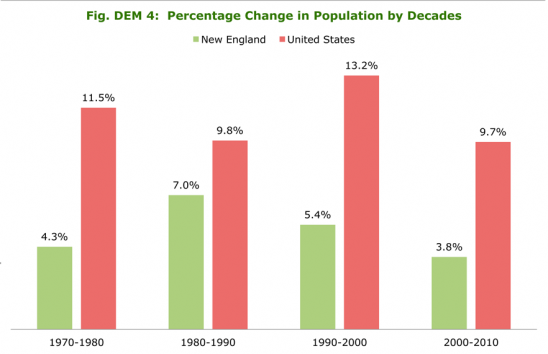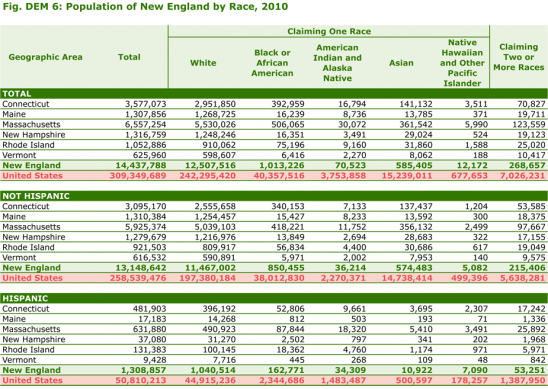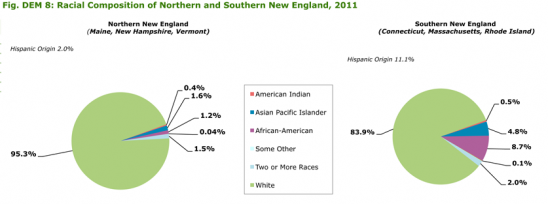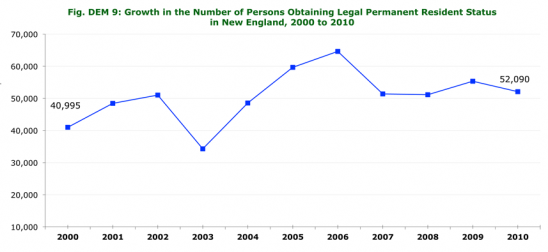Updated May 2012 …
The six-state New England region’s population grew by a sluggish 3.8% between 2000 and 2010—while the nation’s as a whole grew by 9.7%, according to U.S. Census Bureau’s 2010 population figures released in December.
Among other highlights:
• United Van Lines, the nation’s largest household goods mover, classified four of the six New England states as “high outbound” (55% or more moves going out of the state) in 2011. They were: Rhode Island (56.3%), New Hampshire (56.1%), Connecticut (55.8%) and Maine (55.8%).
• For the first time in history, whites accounted for less than half of that total U.S. babies born during the 12-month period ending in July 2011. “Minorities”—Hispanics, blacks, Asians and babies of mixed race—accounted for 50.4%
• It’s not your grandfather’s New England. Exhibit A: The first Somali families moved to Lewiston, Maine, in late Jan. 2001. Ten years later, nearly 10 percent of the city’s population is Somali.
• The Massachusetts population grew by only 3.1%—and the state was the only one in New England to lose a congressional district. Massachusetts had 16 districts in the early 20th century, but will sink to nine in the next Congress.
• As the U.S. population seeks warmth, Texas will gain four seats and Florida two. New York and Ohio will each lose two. Michigan will lose one.
• The historical shift in population from New England to the South and West has gradually brought with it political power, research dollars and college enrollment.
For other trend data, visit Newslink and Trends & Indicators: Continually Updated Stats on New England’s Education and Economy.
Figure DEM 1: Resident Population of New England and the United States: 2010 and 2000 Census
Click on the chart to enlarge.
Note: U.S. data do not include Puerto Rico.
Source: New England Board of Higher Education analysis of U.S. Census Bureau data.
Fig. DEM 2: Resident Population of New England and the United States: 1970-2010 Census
Fig. DEM 3: Percentage Change in New England and United States Population by Decades
Click on the chart to enlarge.
Note: U.S. data do not include Puerto Rico.
Source: New England Board of Higher Education analysis of U.S. Census Bureau data.
Fig. DEM 4: Percentage Change in Population by Decades
Click on the chart to enlarge.
Note: U.S. data do not include Puerto Rico.
Source: New England Board of Higher Education analysis of U.S. Census Bureau data.
Fig. DEM 5: Change in Population, 2000 to 2010, New England States and Other Regions
Click on the chart to enlarge.
Note: Middle Atlantic includes New Jersey, New York, Pennsylvania. East North Central includes Ohio, Illinois, Indiana, Michigan, Wisconsin. West North Central includes Minnesota, Iowa, Missouri, North Dakota, South Dakota, Nebraska, Kansas. South Atlantic includes Delaware, Maryland, District of Columbia, Virginia, West Virginia, North Carolina, South Carolina, Georgia, Florida. East South Central includes Kentucky, Tennessee, Alabama, Mississippi. West South Central includes Arkansas, Louisiana, Oklahoma, Texas. Mountain includes Montana, Idaho, Wyoming, Colorado, New Mexico, Arizona, Utah, Nevada. Pacific includes Washington, Oregon, California, Alaska, Hawaii.
Source: New England Board of Higher Education analysis of U.S. Census Bureau data.
Fig. DEM 6: Population of New England by Race, 2010
Click on the chart to enlarge.
Note: The above categories reflect the U.S. Census Bureau Guidance on the Presentation and Comparison of Race and Hispanic Origin.
Source: New England Board of Higher Education analysis of U.S. Census Bureau data.
Fig. DEM 7: State Projections of Population Aged 60 and Over
Click on the chart to enlarge.
Source: New England Board of Higher Education analysis of U.S. Census Bureau data.
Fig. DEM 8: Racial Composition of Northern and Southern New England, 2011
Click on the chart to enlarge.
Source: New England Board of Higher Education analysis of U.S. Census Bureau data.
Fig. DEM 9: Growth in the Number of Persons Obtaining Legal Permanent Resident Status in New England, 2000 to 2010
Click on the chart to enlarge.
Source: New England Board of Higher Education analysis of U.S. Department of Homeland Security data.
[ssba]


